Abstract
This study presents an innovative framework for leveraging the potential of AI in energy systems through a multidimensional approach. Despite the increasing importance of sustainable energy systems in addressing global climate change, comprehensive frameworks for effectively integrating artificial intelligence (AI) and machine learning (ML) techniques into these systems are lacking. The challenge is to develop an innovative, multidimensional approach that evaluates the feasibility of integrating AI and ML into the energy landscape, to identify the most promising AI and ML techniques for energy systems, and to provide actionable insights for performance enhancements while remaining accessible to a varied audience across disciplines. This study also covers the domains where AI can augment contemporary and future energy systems. It also offers a novel framework without echoing established literature by employing a flexible and multicriteria methodology to rank energy systems based on their AI integration prospects. The research also delineates AI integration processes and technique categorizations for energy systems. The findings provide insight into attainable performance enhancements through AI integration and underscore the most promising AI and ML techniques for energy systems via a pioneering framework. This interdisciplinary research connects AI applications in energy and addresses a varied audience through an accessible methodology.
1. Introduction
The application of artificial intelligence (AI) technologies is witnessing a significant upward trend. Expected to reach a market value of 190.61 billion USD by 2050, AI involves programming computers to make intelligent decisions by identifying patterns and enabling them to learn from data [1]. This rapid development of AI is indelibly associated with multidimensional constraints, including the lack of expertise and professionals to deploy it as an emerging part of future technology, as well as institutional, behavioral, cultural, psychological, ethical, and social concerns. Over time, from its early attempt to become expert in given systems to today’s revolution, AI has been defined by a singular statement; this statement is straightforward: “Artificial Intelligence is the study of how to make computers do things at which, at the moment, people are better.”, if the term of “things” is ignored [2]. Interdisciplinary studies demonstrated a broad knowledge of the topics involved. Energy systems analysis in the computational intelligence and data science domain using machine learning (ML) methods is a data-driven model susceptible to data quality variation. Analysis of systems in the energy domain requires in-depth domain knowledge. So, onboarding energy models, especially power systems, to a digestible data set for ML requires interdisciplinary domain knowledge. This study uses a simplified representation to deal with the most used ML methods in energy systems. Hence, extracting high-quality datasets from the target model and incorporating domain knowledge, such as physical and mathematical models, are crucial for accurate system modeling and analysis.
Standardizing energy systems for AI integration involves transitioning from a conventional parameter-based model to a data-driven model. In a parameter-based model, the system is modeled and controlled using a predefined set of parameters, such as equipment rating, operating conditions, etc. While this approach can be practical for primary control and monitoring, it can be constrained in its ability to adapt to changing conditions and optimizing performance. Conversely, a data-driven model uses real-time data from sensors and other sources to train and update the model, allowing for more precise monitoring, control, predictions, optimization, and so on. A data-driven approach can be utilized to enhance performance and augment the overall efficiency of the energy system. Machine learning and deep learning (DL), especially neural networks, can be employed to analyze and interpret the datasets and construct model architectures that can supervise current operating conditions and predict future system behavior. Standardizing energy systems for AI integration also requires designing a roadmap that includes initiation, planning, design, implementation, optimization, etc.; this roadmap can provide real-time interactions and implement communication protocols that facilitate data sharing and integration with other systems through different protocols and standards. This approach aims to transform energy systems models from parameter-based to data-driven, enabling the integration of different techniques and solutions on a single platform. Ultimately, standardizing energy systems for AI integration can boost the performance and efficiency of these systems, ensuring highly reliable operations and control. This, in turn, promotes long-term sustainability while adhering to techno-economic constraints.
Data-driven models have been extensively studied and posited as viable solutions for several applications that span multiple interdisciplinary fields, particularly in smart energy systems. The literature indicates that data-driven models possess the potential to serve as a powerful tool for enabling parameter-based analysis of a system by leveraging the rich information encoded in datasets to gain insight into the underlying dynamics of a system and make predictions about its behavior. These models have demonstrated their utility in a wide range of applications and are expected to continue playing a more crucial role in advancing energy systems automation and control. However, it is essential to note that, in order for these models to be widely adopted and utilized effectively, it is necessary to demonstrate their scalability and real-world implementation capabilities [3]. Dobbe et al. [4] conducted case studies based on numerical formulation and data-driven modeling regarding frequency regulation and distribution system control to provide general guidelines on integrating learning capabilities for control purposes to make safety risks a central design tenet. Zienkiewicz et al. [5] established a computationally simple, less data-intensive, fast, and efficient data-driven model through a novel hybrid data-driven model. Geneva et al. [6] propose a novel data-driven framework that improves model predictions and provides probabilistic bounds for fluid quantities such as velocity and pressure. Arridge et al. [7] aim to provide an account of some of the main contributions in data-driven inverse problems. Singh et al. [8] introduced a novel ML-based fusion model, known as PI-LSTM (Physics-Infused Long-Short-Term Memory Networks), that integrates first-principles physics-based models and Long-Short-Term Memory (LSTM) networks. Kollmann et al. [9] developed a DL model based on a convolutional neural network (CNN) that predicts optimal metamaterial designs. Runge et al. [10] offer a review of studies published since 2000 that have applied artificial neural networks to forecast building energy use and demand, focusing on reviewing the applications, data, forecasting models, and performance metrics used in model evaluations. Baptista et al. [11] studied the applicability of the Kalman filter to filter the estimates of the remaining useful life. Terzi et al. [12] present work that integrates 1314 vertical profiles of PAR acquired by 31 BGC-Argo floats operating in the Mediterranean Sea between 2012 and 2016 into a one-dimensional model to simulate the vertical and temporal variability of algal chlorophyll concentrations. A systematic method to select the optimal network architecture is proposed and tested in [13]. Bättig, P., and Schiffmann, J. [14] demonstrated that data-driven models were employed to predict the stiffness and damping coefficients of various nitrile butadiene rubber (NBR) O-ring sizes. These predictions were based on O-ring geometry, Shore hardness, squeeze, and excitation frequency. The authors also suggested that the curvature ratio (d/D) should be considered when developing reduced-order models. Data-driven approaches are widely applied for controlling, monitoring, and optimizing energy systems. Among the many studies on the topic, some are highlighted based on their specific applications, including economic load dispatch [15], voltage stability and regulation [5,16], restoration of system fault identification [17,18], planning and forecasting [19,20], network observability [21,22], frequency regulation and stability [23,24,25], system storage and power management [26,27], demand side management [28,29], electricity theft control [30,31], and unit commitment and power management [20]. Feature engineering methods for data-driven model analysis are extensively applied for various domains with original and modified applications, including the analysis of crowd-sourcing materials science [32].
This study makes a tangible contribution to sustainable energy systems by presenting a novel multidimensional framework for integrating AI and machine learning techniques, thereby filling a critical gap in the existing literature. The study evaluates the feasibility of AI and ML integration into the energy landscape and identifies and ranks energy systems based on their AI integration prospects. By delineating AI integration processes and categorizing techniques for energy systems, the findings offer valuable insights into potential performance enhancements and highlight the most promising AI and ML applications for sustainable energy. Furthermore, the interdisciplinary nature of this research and its accessible methodology ensure that it caters to a wide range of stakeholders, fostering collaboration and knowledge exchange across different domains.
In addition, this study can bridge energy engineering, data science, and computer science, presenting knowledge between domains from fundamental modeling concepts to advance energy systems numerical modeling, system linearization, simulation, and optimization in the broader picture. In addition, various ideas of the possibility of applying ML in energy systems are highlighted; these may provide good hints for further research. Although AI involves cross-disciplinary studies, encompassing coding, algorithms, statistics, probability, algebra, big data, and critical thinking, this study also presents a roadmap for acquiring essential knowledge on on-demand intelligence and its adoption. This understanding will empower readers to apply these tools and techniques to complex models and case studies, utilizing platforms that support the application process [33]. This study applies the methods and algorithms of the selected methods to create, expand, select, sort, redact, linearize, validate, and ensure quality-optimized datasets using MATLAB® and Python language as simulation tools. Python language is preferred for simulation due to its open-source nature, extensive libraries, ease of learning, versatility, large community, and seamless integration with other tools, unlike other proprietary specializations. Eventually, this study’s primary objective and potential reside in devising a cutting-edge framework that seamlessly incorporates artificial intelligence and machine learning methodologies into sustainable energy systems, as emphasized in the Introduction.
The paper discusses the transformation of energy system modeling from parameter-based to data-driven models in Section 2, while Section 3 examines the competitive energy policy landscape in the era of AI. Section 4 delves into the role of AI and ML in the transformation of the energy sector for a sustainable future, including process flow, mathematical representation, and simulation results. The article concludes with a summary of the findings in the Conclusion section.
2. Modeling: From Parameter to Data
AI applications for energy transition and climate change mitigation in the context of promoting renewable energy technologies and power systems operation with maximum efficiency and optimum results at large-scale performance are limited to research that will shortly lead to extensive exploitation. Key areas that will shape the future of sustainable energy and require the emergence of intelligent technologies include optimal planning, automation, reliable operation, financial optimization, predictive maintenance, real-time monitoring, demand forecasting, smart grid management, renewable energy integration, energy storage management, efficiency improvement, and emission reduction. These interconnected domains will be critical in driving advancements in sustainable energy systems. Automation of energy systems planning and operation, aided by AI technologies, provides modern infrastructures primarily operated by robotic technologies, ensuring high accuracy and intelligent control in terms of actuation, interaction, and responsiveness to dynamic conditions. As contemporary energy landscapes transition towards Industry 5.0 standards, they integrate the concept of “man and machine”, known as collaborative robots (cobots) [34]. Cobots, designed with advanced kinematic and dynamic capabilities [35], aim to incorporate systems and society through intelligent technologies, fostering agility and resilience. Although there are concerns about job displacement and labor market changes, cobots can support societies with aging populations rather than entirely replacing the workforce.
Usually, energy systems offer sophisticated models in terms of interdependency and interrelation of components and system behavior. Therefore, modeling complex characteristics leads to non-linear patterns that can be time-consuming to handle, such a complicated task. Evaluation of the dynamic characteristics of an energy system requires an in-depth analysis before exploring its mathematical models for swapping to ML compiling architecture models. Underlying relationships among transformation processes require a feedback loop to confirm the model performance accuracy with its original version and to evaluate the impact of sensitivity and variability. Therefore, a feedback loop among the model processes and interactions at different data exchange levels is required because inappropriate dataset input leads to poor characteristics and overall performances of the regenerated model.
Data-driven methods are a promising solution for enabling system parameter-based analysis, leading to improved operation and reliability [36]. However, a lack of standardization is evident in the transformation from system-parameter-based to data-driven-based models. There is a need for benchmarking among various methodologies, tools, and techniques being employed. In addition, the scalability and real-world implementation capabilities of these data-driven models must be demonstrated to achieve widespread adoption and integration into various industrial domains. Establishing a robust framework and benchmarking protocols to evaluate these models’ performance, comparability, and generalizability is important. More research is needed to explore integrating other sources of building energy flexibility, such as thermal energy storage, batteries, electric vehicles, and onsite generation. The next step is to keep energy policies updated and aligned with fast-growing technologies. This requires a principal change in system modeling approaches from system parameter models to data-driven models, as shown in Figure 1. Measurement system analysis is used for data collection at two levels: (1) actual system parameters and performances in real-time, and (2) past or existing data for demand analysis with high accuracy.
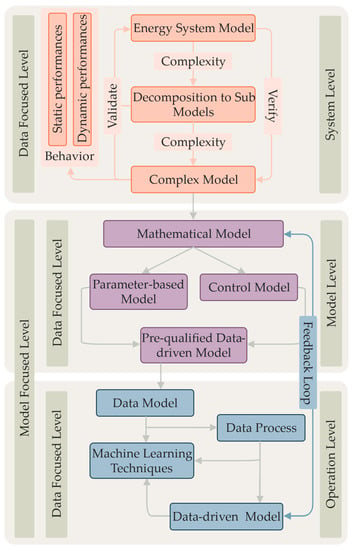
Figure 1.
The thematic framework illustrates the systematic process of transferring the system parameter-based model to a data-driven based model.
The thematic framework proposed in Figure 1 offers a comprehensive roadmap for transforming an energy system into its decomposable components through a systematic procedure. This approach minimizes the probability of errors by converting a system parameter-based model to a data-driven model suitable for ML analysis. A vital advantage of this framework is its ability to ensure a process that validates both the system model and the performance equivalency.
A primary transition in system modeling approaches from parameter-based to data-driven models is required to keep energy systems aligned with fast-growing technologies. In other words, modeling and analysis methods in old-fashioned energy systems require swapping to utilize ML inputs (datasets). Some immediate benefits of the power system data-driven model for various applications compared to the parameter-based system are summarized in Figure 2, which is idealized from [37].

Figure 2.
A visual representation of the advantages and disadvantages of data-driven models in the energy sector shows the balance between the potential improvements and the challenges these models face in addressing the sector’s unique requirements and demands.
The merits and demerits of data-driven models in the energy systems shown in Figure 3 highlight the potential improvements that data-driven models can bring to various aspects of the energy sector. Accurate forecasting is essential for efficient energy management; data-driven models excel at identifying patterns and trends in historical data. Optimal allocation of resources is a priority in the energy sector, and these models can analyze historical and real-time data to improve efficiency. Enhanced maintenance is another key advantage, as predictive analytics can identify potential equipment failures, thereby increasing reliability. Furthermore, the deployment of renewable energy resources into the energy sector is an urgent necessity to address and mitigate the impacts of climate change. Data-driven models can facilitate this by accurately predicting production from renewable sources technically and financially. The drawbacks of data-driven models stem from the prevalent limitations and challenges encountered while applying such models within the energy sector. Data quality and availability are critical factors, and limitations in these areas can hinder the effectiveness of models. The complexity of data-driven models can present challenges with respect to the specialized knowledge and resources required, which may be barriers for some energy utilities companies. Overfitting is another common technical issue in data-driven models, which can lead to inaccuracies when applied to new, unseen data. Adaptability is also crucial in the rapidly evolving energy sector; data-driven models may struggle to keep up with new technologies, regulations, or competitive market conditions.
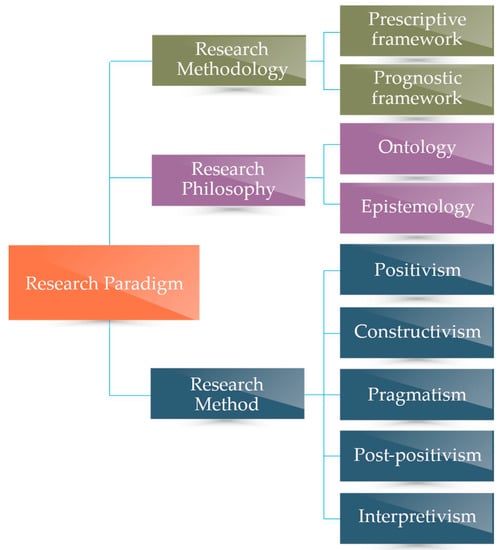
Figure 3.
An overview of the research process hierarchy recommended for research and development of sustainable energy policies.
Engineering planning and design are crucial to reliable supply with high customer satisfaction. Accurate system supply forecasting for maintaining stability and meeting current and future demands necessitates transcending traditional forecasting approaches that solely depend on historical data and system parameters. When integrating renewable resources and smartness of supply-demand through instantaneous metering loads, systems operate using a dynamic nature that traditional methods cannot replicate. Utilizing machine learning for load forecasting allows power systems to adopt a real-time measurement data approach rather than relying on system parameter-based data. This can be applied under steady-state conditions at a single operating point without observing the system’s dynamic behavior [38].
Integrating intelligent technologies in the energy sector will significantly impact policy and system modeling due to changing priorities, investments, and competitive energy markets. Developing countries, particularly those with predominantly rural communities adversely affected by climate change and financial instability, are more vulnerable to these shifts, as they may lack the resources necessary for significant initial investments. Feature engineering methods, which involve generating new features or attribute modifications, employ techniques such as creation, filtering, selection, expansion, transformation, or formulation or utilize time-based system performance values to develop novel features [39]. Feature engineering deals with the existing system dataset to improve quality through optimal feature changes such as adding, modifying, expanding, transforming, filtering, selecting, encoding, formulation, etc. [33]. In contrast to feature creation, the feature selection method (forward and backward selections) of the expansion of the existing data set is used to reduce the size of the feature set; this can cause redundancy and sparsity or multicollinearity in the data [40]. In addition, ML bestows accuracy with high processing speed, turns complicated knowledge-based status models of system performance and interconnected behavior into a simple output, creates models from real-time data, and allows the machine to learn and map optimum output.
Generally, energy systems consist of various setups aligned together in a dynamic operation nature for a reliable and techno-economic supply. Dynamic and transient behavior of systems offers sophisticated observation of multidimensional and non-linear relationships that require a competency analysis package to overcome these challenges. In addition to the challenge of assessing system insight, envisioning the system’s future for planning and expansion presents significant difficulties that are not readily achievable using conventional tools and methods. AI and its specific subsets of ML and DL tools and techniques allow the energy sector to corroborate with optimizations using numerous packages of in-build functions that support multidimensional-nonlinear-interrelated systems (subsystems) with high accuracy and less computational time.
3. Competitive Energy Policy at the Era of AI
The study paradigm is founded based on triple methodology patterns (except the “Critical” that is often used for social science studies), establishing a clear understanding of emerging theories and anticipated outcomes of the research practices, as shown in Figure 3 (adapted from [41,42,43]). From the building block perspective, the research paradigm in the field of energy consistently addresses the importance and reality of practices and analysis of applied methodologies aligned with the research paradigm in the context of ontology, epistemology, and research methodology requirements. From the behavioral point of view, the research paradigm follows mixed-rational positivism (quantitative, experimental), constructivism (qualitative), and pragmatists (predict and optimize) paradigms. The predictive approach demonstrates its potential to inform energy policy in the age of AI, supported by the recommended prescriptive framework’s practical applications.
A research paradigm forms the foundation of the research process, guiding the choice of philosophy, methodology, and methods. Research philosophy encompasses ontology, which studies the nature of reality, and epistemology, which examines the nature of knowledge. Research methodology, informed by paradigm and philosophy, includes prognostic and prescriptive frameworks that predict outcomes and recommend optimal actions. Research methods, such as positivism, constructivism, pragmatism, postpositivism, and interpretivism, reflect specific data collection and analysis approaches, each with a unique emphasis on objectivity, subjectivity, or practicality.
The author has extensively researched energy system sustainability, focusing on addressing real world challenges beyond theoretical suggestions. The proposed topic led to an in-depth exploration of the literature, revealing the fundamental foundation of long-term sustainable energy planning. The study highlights the importance of examining the perspectives on current and future energy trends and the points of view from which we observe these trends. It is crucial to understand that before proposing solutions, the study requires the root causes of the challenges, balances demand and the expected growth rate, and aligns with the philosophy and methodology of effective research with real-time implications. Consequently, these concepts are briefly discussed in Figure 3 to emphasize the importance of a systematic outlook. Although a detailed examination is beyond the scope of this study, these ideas will be applied in future research through various scenarios.
Energy policy is a set of laws, regulations, and actions that a government or utility company takes to manage the generation/import/export, transmission/distribution, and consumption of energy; these are piloted by an energy policy paradigm in a broad overarching framework. The energy policy structure includes institutional arrangements and administrative frameworks that govern the development, implementation, and evaluation process of energy policy. A systematic and integrated approach that employs various analytical tools and techniques, stakeholder participation, evidence-based decision-making, etc., is defined under the policy methodology. Goals and objectives, values and principles, and methods and tools, including regulations, incentives, research and development programs, etc., are the components of a policy paradigm. Tracking and assessing the reliability and sustainability of the energy supply chain, circular economic resilience, reduction of greenhouse gas emissions, enhancement of energy efficiency and conservation, investments in energy infrastructure, and access to affordable energy are just a few of the key aspects that utilize energy policy indicators and indices. Various indices are introduced to measure progress towards achieving Sustainable Development Goal 7 (Affordable and Clean Energy), including the Renewable Energy Share Index, Renewable Energy Capacity Index, Renewable Energy Generation Index, Energy Efficiency Index, Energy Intensity of the Economy, Renewable Energy Access Index, Renewable Energy Prices Index, Renewable Energy Investment Index, and Renewable Energy Employment Index [44]. These indices can provide quantitative and comparative tools for stakeholders to facilitate communication and develop strategies using various potential applications, such as measuring progress toward achieving sustainable energy goals, benchmarking progress between countries, identifying areas for improvement in energy policies and programs, monitoring and reporting on implementation, promoting renewable energy and energy efficiency, evaluating the effectiveness of policies, and supporting decision-making processes.
Integrating AI and ML into energy systems can be approached from many perspectives and applied to various use cases. In this context, we focus on the techno-economic energy balance landscape as an area of interest (Figure 4). This framework encompasses a wide range of applications, including optimizing generation, economic dispatch, and management of energy resources and infrastructure. Incorporating AI and ML techniques into this landscape can lead to more efficient and sustainable energy systems, enabling better demand forecasting, capacity planning, and resource allocation. Furthermore, integrating these advanced technologies can help identify new opportunities for cost reduction and revenue generation while promoting cleaner energy sources and minimizing environmental impacts. By harnessing AI and ML for techno-economic energy balance, decision-makers, and policy developers can enhance the resilience and reliability of energy systems, ensuring a stable power supply even amid fluctuating demand and resource availability. Furthermore, AI and ML mitigate risks associated with extreme weather events, equipment failures, and other unforeseen disruptions.
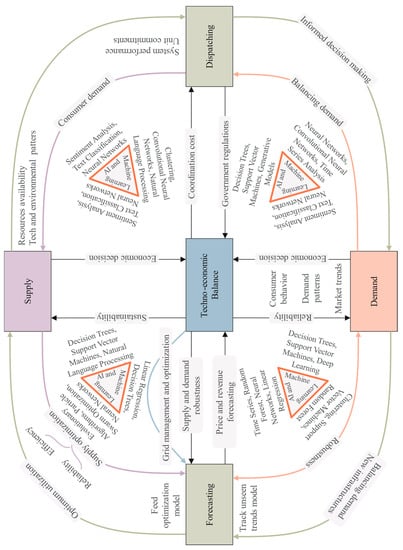
Figure 4.
An overview of the techno-economic energy balancing landscape highlighting the integration of AI and ML into various energy system applications by distinguishing the triangle of AI and ML methods.
Choosing a method depends on various factors, necessitating an examination of the problem’s nature and complexity, the availability of data, and the model’s accuracy and interoperability. Nonetheless, the proposed ML methods are optimally suited for the intended applications or operations.
4. AI and ML: Transforming the Energy Sector
Although AI is gradually permeating all aspects of life, 93% of the existing technical infrastructure does not meet the optimal integration requirements, not to mention the upfront costs associated with its deployment. To overcome this issue, platforms must prepare for a critical change that demands inter-domain collaboration. In addition to data scientists and AI experts, other engineering domains will deal with AI directly or indirectly, offering expensive programming, new tools, and techniques. Therefore, this section focuses on representing selected applied data science tools and techniques in energy engineering, followed by examples that enable energy field researchers, students, and practitioners to acquire essential knowledge of applied AI in energy planning and design. This study aims to categorize the essential ML methods and tools primarily used in energy systems studies. It then presents these methods to properly approach the appropriate white-box, gray-box, and black-box techniques [45], utilizing suitable programming languages such as Python, MATLAB®, and so on. This creates an interface for simulation packages designed to achieve the best solutions.
Many studies have employed diverse estimations and weighting adjustments to reduce biases stemming from nonresponse and non-coverage systems [46]. In this context, priority is given to pairwise comparison using magnitude scaling, ideal point methods [47], and Analytic Hierarchy Process (AHP) methods [48]. The weights are determined by considering the relative importance of each element in the scenarios, with expert judgment and the Delphi approach for support [49,50]. However, evaluating qualitative scenarios with quantitative measures is challenging due to the subjectivity of qualitative data and proxy limitations [51]. This may result in inaccuracies and biases, thereby complicating interpretation [52]. Using appropriate methods and careful understanding is crucial to ensuring validity and robustness. Therefore, a multidimensional approach utilizing a systematic methodology (Figure 5), including the AHP method [53], is employed to estimate qualitative weighting scores for the analyzed scenarios [54]. AHP is a structured technique for organizing and analyzing complex decisions involving qualitative and quantitative factors, providing a consistent and structured approach for weighing non-quantitative factors and prioritizing scenarios [55]. These scenarios can be tailored based on specific deployment needs and priorities.
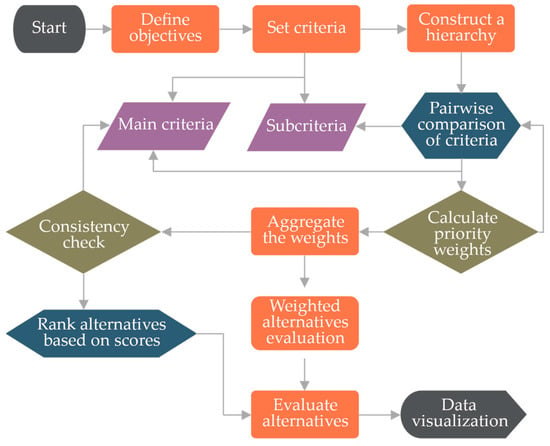
Figure 5.
Analysis process flowchart of policy building block scenarios and AI techniques, offering a consistent and structured approach to weighing nonquantitative factors, prioritizing, and comparing the scenario.
4.1. The Process Flow
This study focuses on multicriteria objective analysis using the Analytic Hierarchy Process (AHP) (Python codes are given in Appendix A). AHP is a structured decision-making technique that compares alternatives based on multiple criteria and sub-criteria. The methodology involves constructing a hierarchy of criteria, assigning weights to criteria and sub-criteria, and evaluating alternatives based on each sub-criterion. The final output for each alternative is a normalized score that reflects its overall preference, following the steps in Figure 6.
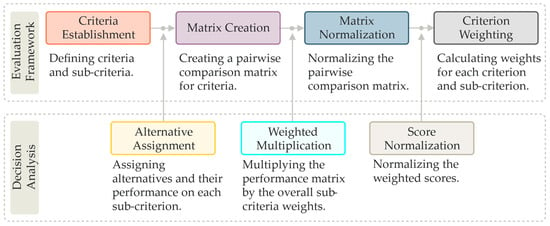
Figure 6.
The two-stage decision-making process consists of the evaluation framework and decision analysis.
The proposed flowchart and the framework aim to assess the potential applications of AI and ML techniques (referenced in Table 1) in various energy policy scenarios while considering sustainability requirements. To achieve this objective, the following criteria are identified to evaluate the impact of AI and ML methodologies in energy systems:

Table 1.
The relationship between scenario codes and AI techniques, where 1 indicates that the technique is used in the given scenario and 0 indicates that it is not.
- Technical feasibility (TF)
- Environmental Impact (EI)
- Economic Viability (EV)
- Social Acceptability (SA)
- Regulatory Compliance (RC)
These criteria are subsequently assessed through a sub-criteria evaluation to gain deeper insights into the relevant and measurable aspects. The sub-criteria for the five criteria prioritize environmental impact, focusing on carbon emission reduction (as depicted in Figure 7).
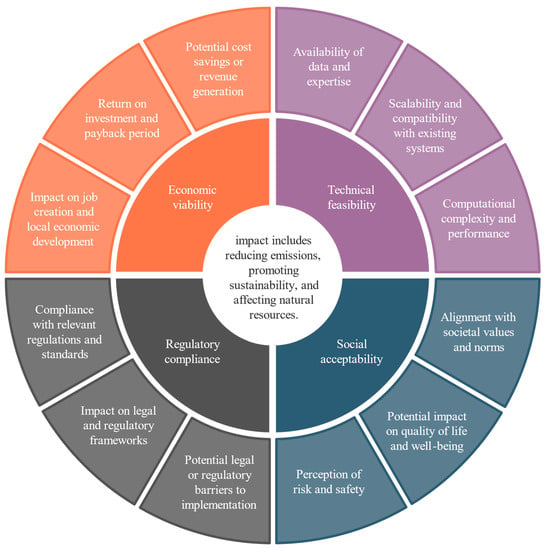
Figure 7.
Evaluating criteria using sub-criteria for the five evaluation criteria, focusing on environmental impact.
The analytical hierarchy process (AHP) is used to assign weights to criteria to reflect their relative importance. This involves creating a pairwise comparison matrix to show each criterion’s importance when compared to others, normalizing the matrix, and calculating priority weights. The consistency ratio (CR) is estimated to check the consistency of the pairwise comparison matrix; if it is less than 0.1, the matrix is considered consistent.
Evaluating alternatives involves several steps, including assessing each item based on sub-criteria, normalizing the data, calculating the weighted scores, and ranking the items. First, each item is evaluated on a scale of 1 to 5, based on how well it satisfies each sub-criterion. Then, the data are normalized by dividing each element by the sum of its column. The weighted score is then calculated for each item by multiplying its normalized score for each sub-criterion by the weight of that sub-criterion and proceeding with summing these products across all sub-criteria. Finally, the items are ranked according to their total weighted score, with higher scores indicating better performance.
Analyzing AI and ML techniques in energy systems provides insight into promising areas of focus. High-ranked items are prioritized for investment and promotion, while lower-ranked items require further evaluation. The model involves defining the objective, identifying criteria and sub-criteria, assigning weights using AHP, evaluating alternatives, and interpreting results. The weights can be adjusted to reflect priorities and preferences. The consistency of the pairwise comparison matrix must be checked. The proposed model offers a structured and comprehensive approach to evaluating AI and ML energy system deployment techniques.
4.2. Mathematical Representation of the Process
Pairwise Comparison Matrix: A pairwise comparison matrix determines the relative importance of elements (criteria or sub-criteria) in the decision-making process, assigning a predefined scale (e.g., 1 to 9). In the below matrix, the elements represent the preference of element over element [76]:
is the pairwise comparison matrix with dimensions , where is the number of elements being compared.
Criteria weights: Calculating the criteria weights can be performed using various methods, including the Analytic Hierarchy Process (AHP), the Analytic Network Process (ANP), or direct weighting, to quantify the relative importance of each criterion in the decision-making process. If is the weight of criterion , the weights of the criteria are represented as the following vector [76]:
where .
Sub-criteria Weights: Similar to criteria weights, sub-criteria weights calculated weighting to create pairwise comparison matrices for each criterion and calculate the corresponding weights for each sub-criterion. For each criterion , is the weight of sub-criterion . Then, the sub-criteria weights for the criterion vector are given as follows [76]:
where .
Alternatives and weighted performance matrix: The performance matrix () is a prerequisite to track the performance of each alternative regarding each criterion. Multiply each column of the performance matrix () by the corresponding weight from the weight vector of the criteria (W). The weighted performance matrix is given as:
is the performance matrix with dimensions , where is the number of alternatives and is the number of criteria. Let be the weight vector of the criteria.
Weighted Scores: Multiplying the weighted performance matrix () by the criteria weights vector () will result in a weighted score for each alternative, which considers both the performance of the alternatives and the importance of each criterion.
where is the score vector for each alternative.
Normalized scores: Calculating the sum of all weighted scores () is a prerequisite for normalizing the scores. Divide each weighted score by the sum of all weighted scores to obtain the normalized scores (). Normalized scores contribute to comparing alternatives on a scale from 0 to 1, as given below [76]:
where, is the number of alternatives, and and are the original and normalized score vectors.
4.3. Simulation and Results
In this study, we compare five alternatives for a given problem, using the Analytic Hierarchy Process (AHP) to evaluate their performance and rank them based on their normalized scores. Alternative 4 (A4) emerges as the top choice, significantly outperforming the other options. While Alternatives 1, 2, and 5 exhibit relatively close scores, they do not surpass the performance of A4. Alternative 3 is identified as the least preferred option. The AHP provides a valuable foundation for our analysis, but it is crucial to recognize that decision-making often involves multiple factors and complex considerations. Therefore, our findings should be used as a starting point for further discussions, incorporating additional factors before reaching a final decision.
Alternative 4 (A4) has the highest normalized score (0.3071), indicating that it is the most preferred option. The other alternatives have relatively close scores, with A2 second (0.2146), followed by A5, A1, and A3. The normalized scores highlight each alternative’s performance: A1 (0.1994) and A2 (0.1989) are good options; A3 (0.1823) is the least preferred; A4 (0.2192) is the best choice; A5 (0.2002) performs slightly better than A1 and A2, but not as well as A4. The study’s findings reveal that A4 is the best choice among the five alternatives, with a remarkable normalized score of 0.2192. While A1, A2, and A5 provide viable options, they do not surpass A4’s performance. A3, which has the lowest score (0.1823), falls behind the others. Based on AHP, A4 is the recommended alternative. However, decision-making encompasses multiple factors, and assigned weights might not capture the full complexity. The results shown in Figure 8, Figure 9, Figure 10 and Figure 11 can serve as a basis for further analysis and discussions, integrating additional factors before reaching a final decision.
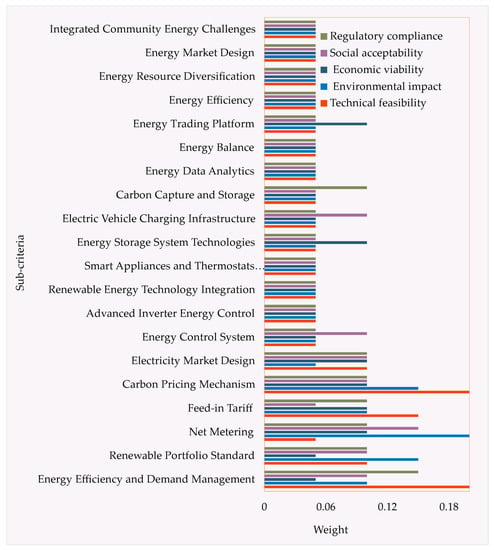
Figure 8.
Criteria (equal importance assigned to all five criteria) and sub-criteria weights (varying importance assigned to sub-criteria within each criterion).
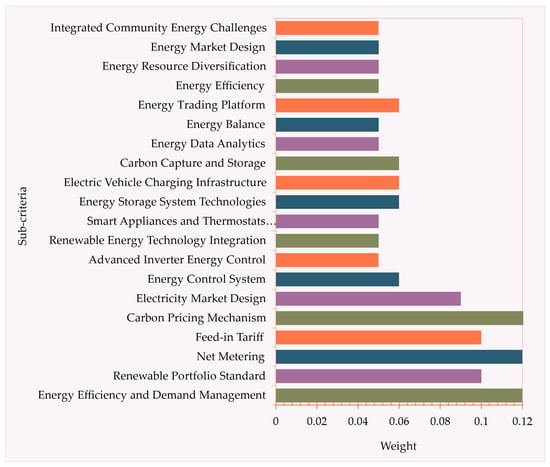
Figure 9.
Overall sub-criteria weights (consolidated view of sub-criteria importance, calculated by multiplying criteria weights and sub-criteria weights).
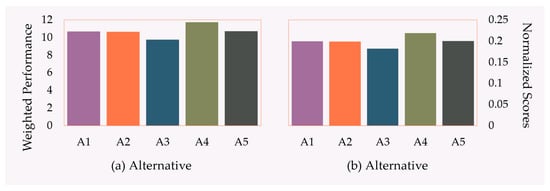
Figure 10.
(a) Weighted performance matrix (performance scores of the alternatives across all sub-criteria), and (b) Normalized scores (relative performance of alternatives, calculated by dividing the weighted performance matrix scores by their sum).
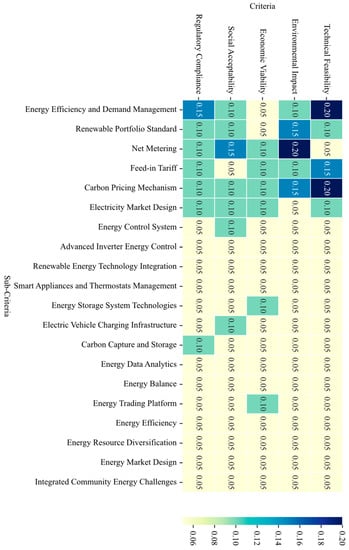
Figure 11.
Exploring the influence of the proposed sub-criteria on ai-powered energy policy through visualization of sub-criteria weights across five criteria.
The results demonstrate the prioritization of different criteria and sub-criteria in decision-making. The equal weighting of the criteria (0.2 for each) indicates that all criteria have the same importance. The sub-criteria weights show varying levels of importance within each criterion. The overall sub-criteria weights, calculated by multiplying the criteria and sub-criteria weights, provide a consolidated view of the importance of the sub-criteria. The weighted performance matrix represents the performance scores of the alternatives across all sub-criteria; it shows that the fourth alternative (11.76) performs the best, while the third alternative (9.78) performs the worst. Normalized scores, calculated by dividing the weighted performance matrix scores by their sum, further support these findings. As mentioned earlier, the fourth alternative has the highest normalized score (0.21919851), indicating its superiority, while the third alternative has the lowest score (0.18229264), indicating its inferior performance. The results provide a strong argument for selecting the fourth alternative as the most suitable option based on the criteria and sub-criteria. This study can be considered to be a roadmap for various scenarios based on objectives and priorities from different perspectives.
Integrating AI into energy systems has excellent potential to improve efficiency, optimize resource allocation, and facilitate the transition to a sustainable future [77]. However, it also carries inherent risks, including increased vulnerability to cyberattacks, unintended consequences from algorithmic biases, and possible job displacement; these risks must be carefully assessed and mitigated to ensure the responsible and beneficial implementation of AI technologies [78].
5. Conclusions
The study applied a multicriteria and multiobjective approach to evaluate various scenarios. This proposed method enables decision-makers in the energy sector to structure complex problems, prioritize factors, and systematically compare options. Moreover, the proposed models and a systematic roadmap can be applied to various decision-making scenarios, including business strategy, resource allocation, project management, and circular economy. This study showcases its versatility and adaptability in interdisciplinary settings. Therefore, this is a novel contribution to interdisciplinary endeavors from methodological, comprehensiveness, and implementation perspectives. This research does not replicate the existing literature or validate previous findings but presents an innovative thesis.
Additionally, this study exhaustively examines the pros and cons of data-driven models in energy systems, comparing them with model-based system parameters. This analysis provides a balanced perspective on the potential benefits and challenges associated with the use of data-driven models in the energy sector, empowering stakeholders and utilities to make informed decisions about adopting these methodologies. Simultaneously, integrating AI and ML within the techno-economic energy balancing landscape presents a promising opportunity to enhance the efficiency, sustainability, and resilience of energy systems. This has the potential to catalyze transformative change across the industry.
Funding
This research received no external funding.
Data Availability Statement
Acknowledgments
The author extends his profound gratitude to those who contributed significantly to the completion of this article. Your steadfast support, wise comments and invaluable guidance, particularly during crucial moments, have played an essential role in refining and shaping this work. The author sincerely appreciates your generous contributions and commitment to embark on this journey with us. The author thanks you for your time, effort, and unwavering dedication to the success of this article.
Conflicts of Interest
The author declares no conflict of interest.
Appendix A
This appendix contains the Python language code used to analyze potential AI and ML techniques applications in various energy policy scenarios while considering sustainability requirements. The code performs the following steps:
- Define criteria and sub-criteria related to energy policy scenarios.
- Construct a pairwise comparison matrix for criteria.
- Normalize the pairwise comparison matrix to obtain criteria weights.
- Define the weights for the criterion of sub-criteria.
- Calculate the overall weights of sub-criteria.
- Define alternatives for exploration.
- Create a performance matrix for each alternative, evaluating their performance against the sub-criteria.
- Multiply the performance matrix by the overall sub-criteria weights to obtain a weighted performance matrix.
- Normalize the weighted scores for each alternative.
- Print the results, including criteria weights, sub-criteria weights, overall sub-criteria weights, weighted performance matrix, and normalized scores.
The code provides insights into the relative importance of different criteria and sub-criteria for energy policy scenarios and the evaluation of alternative solutions. The results can be used to inform decision-making processes and guide the development of energy policies that leverage AI and ML techniques while addressing sustainability requirements.
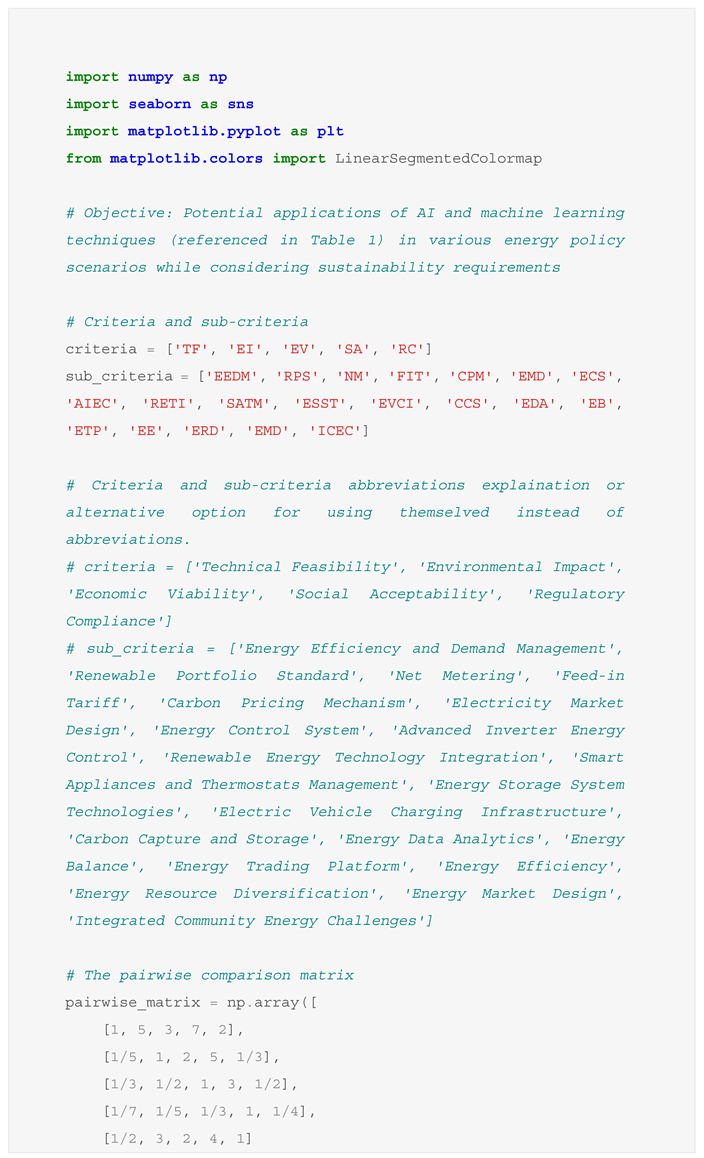
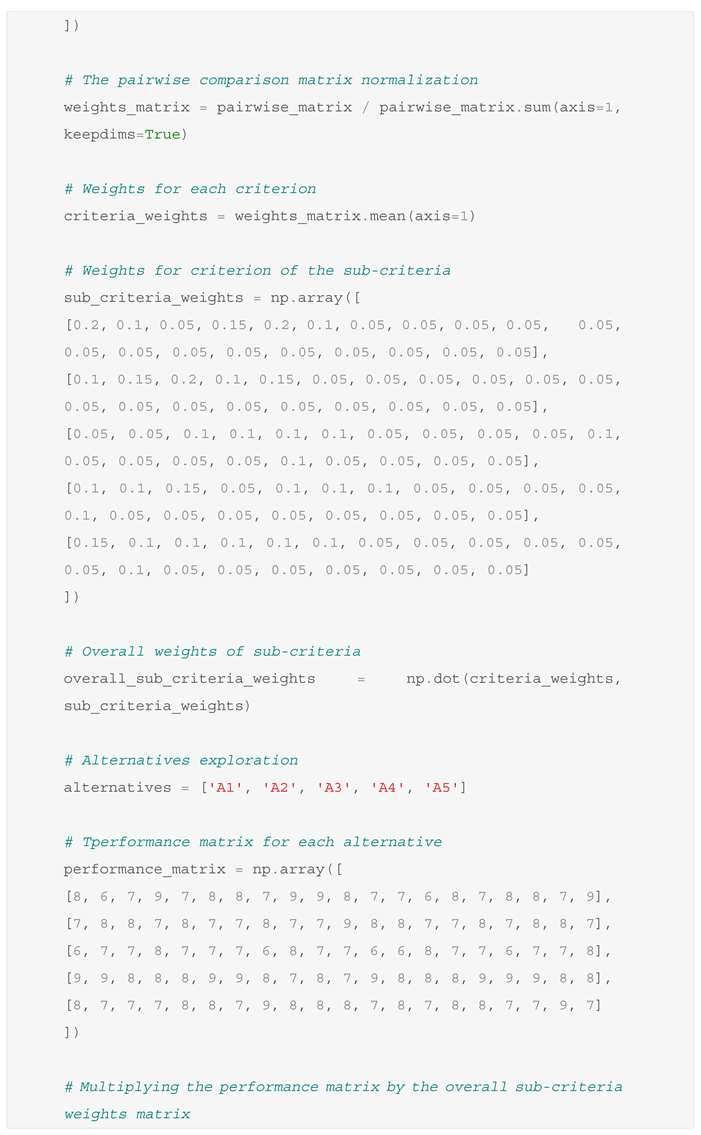
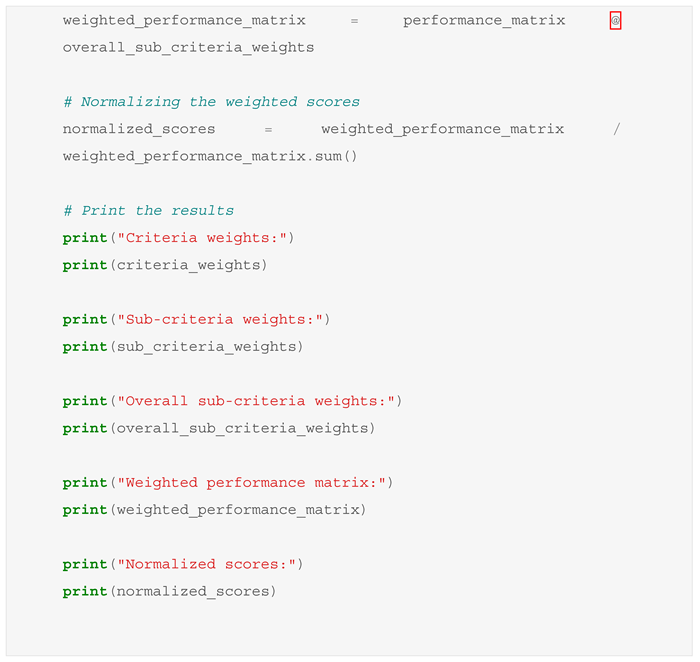
References
- Thamik, H.; Wu, J. The Impact of Artificial Intelligence on Sustainable Development in Electronic Markets. Sustainability 2022, 14, 3568. [Google Scholar] [CrossRef]
- Venkatasubramanian, V. The Promise of Artificial Intelligence in Chemical Engineering: Is It Here, Finally? AIChE J. 2019, 65, 466–478. [Google Scholar] [CrossRef]
- Kathirgamanathan, A.; De Rosa, M.; Mangina, E.; Finn, D.P. Data-Driven Predictive Control for Unlocking Building Energy Flexibility: A Review. Renew. Sustain. Energy Rev. 2021, 135, 110120. [Google Scholar] [CrossRef]
- Dobbe, R.; Hidalgo-Gonzalez, P.; Karagiannopoulos, S.; Henriquez-Auba, R.; Hug, G.; Callaway, D.S.; Tomlin, C.J. Learning to Control in Power Systems: Design and Analysis Guidelines for Concrete Safety Problems. Electr. Power Syst. Res. 2020, 189, 106615. [Google Scholar] [CrossRef]
- Zienkiewicz, A.K.; Ladu, F.; Barton, D.A.W.; Porfiri, M.; Bernardo, M.D. Data-Driven Modelling of Social Forces and Collective Behaviour in Zebrafish. J. Theor. Biol. 2018, 443, 39–51. [Google Scholar] [CrossRef] [PubMed]
- Geneva, N.; Zabaras, N. Quantifying Model Form Uncertainty in Reynolds-Averaged Turbulence Models with Bayesian Deep Neural Networks. J. Comput. Phys. 2019, 383, 125–147. [Google Scholar] [CrossRef]
- Arridge, S.; Maass, P.; Öktem, O.; Schönlieb, C.-B. Solving Inverse Problems Using Data-Driven Models. Acta Numer. 2019, 28, 1–174. [Google Scholar] [CrossRef]
- Singh, S.K.; Yang, R.; Behjat, A.; Rai, R.; Chowdhury, S.; Matei, I. PI-LSTM: Physics-Infused Long Short-Term Memory Network. In Proceedings of the 2019 18th IEEE International Conference on Machine Learning and Applications (ICMLA), Boca Raton, FL, USA, 16–19 December 2019; pp. 34–41. [Google Scholar]
- Kollmann, H.T.; Abueidda, D.W.; Koric, S.; Guleryuz, E.; Sobh, N.A. Deep Learning for Topology Optimization of 2D Metamaterials. Mater. Des. 2020, 196, 109098. [Google Scholar] [CrossRef]
- Runge, J.; Zmeureanu, R. Forecasting Energy Use in Buildings Using Artificial Neural Networks: A Review. Energies 2019, 12, 3254. [Google Scholar] [CrossRef]
- Baptista, M.; Henriques, E.M.P.; de Medeiros, I.P.; Malere, J.P.; Nascimento, C.L.; Prendinger, H. Remaining Useful Life Estimation in Aeronautics: Combining Data-Driven and Kalman Filtering. Reliab. Eng. Syst. Saf. 2019, 184, 228–239. [Google Scholar] [CrossRef]
- Terzić, E.; Lazzari, P.; Organelli, E.; Solidoro, C.; Salon, S.; D’Ortenzio, F.; Conan, P. Merging Bio-Optical Data from Biogeochemical-Argo Floats and Models in Marine Biogeochemistry. Biogeosciences 2019, 16, 2527–2542. [Google Scholar] [CrossRef]
- Nokhandan, A.K.; Snieder, E.; Khan, U.T.; ElDyasti, A.; Ghaemi, Z.; Bagheri, M. A Comparison of Two Data-Driven Models to Predict Hypolimnetic Dissolved Oxygen Concentration: A Case Study of the Seymareh Reservoir in Iran. J. Environ. Inform. Lett. 2019, 2, 70–81. [Google Scholar] [CrossRef]
- Bättig, P.; Schiffmann, J. Data-Driven Model for the Dynamic Characteristics of O-Rings for Gas Bearing Supported Rotors. J. Appl. Mech. 2019, 86, 081003. [Google Scholar] [CrossRef]
- Bellizio, F.; Karagiannopoulos, S.; Aristidou, P.; Hug, G. Optimized Local Control for Active Distribution Grids Using Machine Learning Techniques. In Proceedings of the 2018 IEEE Power & Energy Society General Meeting (PESGM), Portland, OR, USA, 5–9 August 2018; pp. 1–5. [Google Scholar]
- Dobbe, R.; Sondermeijer, O.; Fridovich-Keil, D.; Arnold, D.; Callaway, D.; Tomlin, C. Toward Distributed Energy Services: Decentralizing Optimal Power Flow with Machine Learning. IEEE Trans. Smart Grid 2020, 11, 1296–1306. [Google Scholar] [CrossRef]
- Brahma, S.; Kavasseri, R.; Cao, H.; Chaudhuri, N.R.; Alexopoulos, T.; Cui, Y. Real-Time Identification of Dynamic Events in Power Systems Using PMU Data, and Potential Applications—Models, Promises, and Challenges. IEEE Trans. Power Deliv. 2017, 32, 294–301. [Google Scholar] [CrossRef]
- Ardakanian, O.; Wong, V.W.S.; Dobbe, R.; Low, S.H.; von Meier, A.; Tomlin, C.J.; Yuan, Y. On Identification of Distribution Grids. IEEE Trans. Control Netw. Syst. 2019, 6, 950–960. [Google Scholar] [CrossRef]
- Sun, M.; Cremer, J.; Strbac, G. A Novel Data-Driven Scenario Generation Framework for Transmission Expansion Planning with High Renewable Energy Penetration. Appl. Energy 2018, 228, 546–555. [Google Scholar] [CrossRef]
- Zhao, C.; Guan, Y. Data-Driven Stochastic Unit Commitment for Integrating Wind Generation. IEEE Trans. Power Syst. 2016, 31, 2587–2596. [Google Scholar] [CrossRef]
- Deka, D.; Backhaus, S.; Chertkov, M. Structure Learning in Power Distribution Networks. IEEE Trans. Control Netw. Syst. 2018, 5, 1061–1074. [Google Scholar] [CrossRef]
- Liao, Y.; Weng, Y.; Liu, G.; Rajagopal, R. Urban MV and LV Distribution Grid Topology Estimation via Group Lasso. IEEE Trans. Power Syst. 2019, 34, 12–27. [Google Scholar] [CrossRef]
- Glavic, M.; Fonteneau, R.; Ernst, D. Reinforcement Learning for Electric Power System Decision and Control: Past Considerations and Perspectives. IFAC-Pap. 2017, 50, 6918–6927. [Google Scholar] [CrossRef]
- Ernst, D.; Glavic, M.; Wehenkel, L. Power Systems Stability Control: Reinforcement Learning Framework. IEEE Trans. Power Syst. 2004, 19, 427–435. [Google Scholar] [CrossRef]
- Karagiannopoulos, S.; Dobbe, R.; Aristidou, P.; Callaway, D.; Hug, G. Data-Driven Control Design Schemes in Active Distribution Grids: Capabilities and Challenges. In Proceedings of the 2019 IEEE Milan PowerTech, Milano, Italy, 23–27 June 2019; pp. 1–6. [Google Scholar]
- Karagiannopoulos, S.; Aristidou, P.; Hug, G. Data-Driven Local Control Design for Active Distribution Grids Using Off-Line Optimal Power Flow and Machine Learning Techniques. IEEE Trans. Smart Grid 2019, 10, 6461–6471. [Google Scholar] [CrossRef]
- Xiong, R.; Cao, J.; Yu, Q. Reinforcement Learning-Based Real-Time Power Management for Hybrid Energy Storage System in the Plug-In Hybrid Electric Vehicle. Appl. Energy 2018, 211, 538–548. [Google Scholar] [CrossRef]
- Lu, R.; Hong, S.H. Incentive-Based Demand Response for Smart Grid with Reinforcement Learning and Deep Neural Network. Appl. Energy 2019, 236, 937–949. [Google Scholar] [CrossRef]
- Lesage-Landry, A.; Taylor, J.A. Setpoint Tracking With Partially Observed Loads. IEEE Trans. Power Syst. 2018, 33, 5615–5627. [Google Scholar] [CrossRef]
- Duan, C.; Jiang, L.; Fang, W.; Liu, J. Data-Driven Affinely Adjustable Distributionally Robust Unit Commitment. IEEE Trans. Power Syst. 2018, 33, 1385–1398. [Google Scholar] [CrossRef]
- Jokar, P.; Arianpoo, N.; Leung, V.C.M. Electricity Theft Detection in AMI Using Customers’ Consumption Patterns. IEEE Trans. Smart Grid 2016, 7, 216–226. [Google Scholar] [CrossRef]
- Sutton, C.; Ghiringhelli, L.M.; Yamamoto, T.; Lysogorskiy, Y.; Blumenthal, L.; Hammerschmidt, T.; Golebiowski, J.R.; Liu, X.; Ziletti, A.; Scheffler, M. Crowd-Sourcing Materials-Science Challenges with the NOMAD 2018 Kaggle Competition. Npj Comput. Mater. 2019, 5, 111. [Google Scholar] [CrossRef]
- Wilfling, S. Augmenting Data-Driven Models for Energy Systems through Feature Engineering: A Python Framework for Feature Engineering. arXiv 2023, arXiv:2301.01720. [Google Scholar]
- Huang, S.; Wang, B.; Li, X.; Zheng, P.; Mourtzis, D.; Wang, L. Industry 5.0 and Society 5.0—Comparison, Complementation and Co-Evolution. J. Manuf. Syst. 2022, 64, 424–428. [Google Scholar] [CrossRef]
- Rossato, C.; Pluchino, P.; Cellini, N.; Jacucci, G.; Spagnolli, A.; Gamberini, L. Facing with Collaborative Robots: The Subjective Experience in Senior and Younger Workers. Cyberpsychology Behav. Soc. Netw. 2021, 24, 349–356. [Google Scholar] [CrossRef] [PubMed]
- Feng, Y.; Cui, N.; Chen, Y.; Gong, D.; Hu, X. Development of Data-Driven Models for Prediction of Daily Global Horizontal Irradiance in Northwest China. J. Clean. Prod. 2019, 223, 136–146. [Google Scholar] [CrossRef]
- Danish, M.S.S.; Senjyu, T. AI-Powered Policy for Energy Sustainability 2023. Available online: https://www.researchgate.net/publication/369850945_AI-Enabled_Energy_Policy_for_a_Sustainable_Future (accessed on 3 April 2023).
- Dewangan, F.; Abdelaziz, A.Y.; Biswal, M. Load Forecasting Models in Smart Grid Using Smart Meter Information: A Review. Energies 2023, 16, 1404. [Google Scholar] [CrossRef]
- Wilfling, S.; Falay, B.; Alfalouji, Q.; Schweiger, G. A Dymola-Python Framework for Data-Driven Model Creation and Co-Simulation. In Proceedings of the Asian Modelica Conference 2022, Tokyo, Japan, 24–25 November 2022; The Modelica Conference: Tokyo, Japan, 2022; pp. 165–170. [Google Scholar]
- Zhang, G.; Tian, C.; Li, C.; Zhang, J.J.; Zuo, W. Accurate Forecasting of Building Energy Consumption via a Novel Ensembled Deep Learning Method Considering the Cyclic Feature. Energy 2020, 201, 117531. [Google Scholar] [CrossRef]
- Kankam, P.K. The Use of Paradigms in Information Research. Libr. Inf. Sci. Res. 2019, 41, 85–92. [Google Scholar] [CrossRef]
- DeCarlo, M. 6.2 Paradigms, Theories, and How They Shape a Researcher’s Approach. In Scientific Inquiry in Social Work; Pressbooks: Montréal, QC, Canada, 2018; pp. 144–152. [Google Scholar]
- Proofed Research Paradigms: Explanation and Examples. Proofed. 2022. Available online: https://proofed.com/writing-tips/research-paradigms-explanation-and-examples/ (accessed on 12 January 2023).
- UNEP GOAL 7: Affordable and Clean Energy. Available online: http://www.unep.org/explore-topics/sustainable-development-goals/why-do-sustainable-development-goals-matter/goal-7 (accessed on 24 November 2022).
- Wilfling, S.; Ebrahimi, M.; Alfalouji, Q.; Schweiger, G.; Basirat, M. Learning Non-Linear White-Box Predictors: A Use Case in Energy Systems. In Proceedings of the 2022 21st International Conference on Machine Learning and Applications (ICMLA), Nassau, Bahamas, 12–14 December 2022; pp. 507–512. [Google Scholar] [CrossRef]
- Kalton, G.; Flores-Cervantes, I. Weighting Methods. J. Off. Stat. 2003, 19, 81–97. [Google Scholar]
- Kok, M.; Lootsma, F.A. Pairwise-Comparison Methods in Multiple Objective Programming, with Applications in a Long-Term Energy-Planning Model. Eur. J. Oper. Res. 1985, 22, 44–55. [Google Scholar] [CrossRef]
- Redfoot, E.K.; Verner, K.M.; Borrelli, R.A. Applying Analytic Hierarchy Process to Industrial Process Design in a Nuclear Renewable Hybrid Energy System. Prog. Nucl. Energy 2022, 145, 104083. [Google Scholar] [CrossRef]
- Van Schoubroeck, S.; Springael, J.; Van Dael, M.; Malina, R.; Van Passel, S. Sustainability Indicators for Biobased Chemicals: A Delphi Study Using Multicriteria Decision Analysis. Resour. Conserv. Recycl. 2019, 144, 198–208. [Google Scholar] [CrossRef]
- Project Management Institute. A Guide to the Project Management Body of Knowledge (PMBOK Guide), 6th ed.; Project Management Institute: Newtown Square, PA, USA, 2017; ISBN 978-1-62825-184-5. [Google Scholar]
- Chen, P. On the Diversity-Based Weighting Method for Risk Assessment and Decision-Making about Natural Hazards. Entropy 2019, 21, 269. [Google Scholar] [CrossRef]
- Lowhorn, G.L. Qualitative and Quantitative Research: How to Choose the Best Design. In Proceedings of the Academic Business World International Conference, Nashville, TN, USA, 28 May 2007; pp. 1–5. [Google Scholar]
- Ramanathan, R. Multicriteria Analysis of Energy. In Encyclopedia of Energy; Cleveland, C.J., Ed.; Elsevier: New York, NY, USA, 2004; pp. 77–88. ISBN 978-0-12-176480-7. [Google Scholar]
- Abu Taha, R.; Daim, T. Multicriteria Applications in Renewable Energy Analysis, a Literature Review. In Research and Technology Management in the Electricity Industry; Daim, T., Oliver, T., Kim, J., Eds.; Green Energy and Technology; Springer: London, UK, 2013; pp. 17–30. ISBN 978-1-4471-5096-1. [Google Scholar]
- Miciuła, I.; Nowakowska-Grunt, J. Using the AHP Method to Select an Energy Supplier for Household in Poland. Procedia Comput. Sci. 2019, 159, 2324–2334. [Google Scholar] [CrossRef]
- Krarti, M. Evaluation of Energy Efficiency Potential for the Building Sector in the Arab Region. Energies 2019, 12, 4279. [Google Scholar] [CrossRef]
- Li, W.; Lu, C.; Zhang, Y.-W. Prospective Exploration of Future Renewable Portfolio Standard Schemes in China via a Multi-Sector CGE Model. Energy Policy 2019, 128, 45–56. [Google Scholar] [CrossRef]
- Gabr, A.Z.; Helal, A.A.; Abbasy, N.H. Economic Evaluation of Rooftop Grid-Connected Photovoltaic Systems for Residential Building in Egypt. Int. Trans. Electr. Energy Syst. 2020, 30, e12379. [Google Scholar] [CrossRef]
- Huang, H.; Nie, S.; Lin, J.; Wang, Y.; Dong, J. Optimization of Peer-To-Peer Power Trading in a Microgrid with Distributed PV and Battery Energy Storage Systems. Sustainability 2020, 12, 923. [Google Scholar] [CrossRef]
- Mormann, F. Who Is Going to Pay for and Benefit from the Expansion of Solar Power? Natl. Interest. 2021. Available online: https://nationalinterest.org/blog/reboot/who-going-pay-and-benefit-expansion-solar-power-194923 (accessed on 12 January 2023).
- Cao, K.; Xu, X.; Wu, Q.; Zhang, Q. Optimal Production and Carbon Emission Reduction Level under Cap-And-Trade and Low Carbon Subsidy Policies. J. Clean. Prod. 2017, 167, 505–513. [Google Scholar] [CrossRef]
- Li, H.; Li, R.; Shang, M.; Liu, Y.; Su, D. Cooperative Decisions of Competitive Supply Chains Considering Carbon Trading Mechanism. Int. J. Low-Carbon Technol. 2022, 17, 102–117. [Google Scholar] [CrossRef]
- Tong, W.; Mu, D.; Zhao, F.; Mendis, G.P.; Sutherland, J.W. The Impact of Cap-and-Trade Mechanism and Consumers’ Environmental Preferences on a Retailer-Led Supply Chain. Resour. Conserv. Recycl. 2019, 142, 88–100. [Google Scholar] [CrossRef]
- Inoue, N.; Matsumoto, S. An Examination of Losses in Energy Savings after the Japanese Top Runner Program? Energy Policy 2019, 124, 312–319. [Google Scholar] [CrossRef]
- Sabory, N.R.; Senjyu, T.; Momand, A.H.; Waqfi, H.; Saboor, N.; Mobarez, R.; Razeqi, F. LEED Scores of Residential Buildings in Poor Cities: Kabul City Case. Sustainability 2021, 13, 6959. [Google Scholar] [CrossRef]
- Castrillón-Mendoza, R.; Rey-Hernández, J.M.; Rey-Martínez, F.J. Industrial Decarbonization by a New Energy-Baseline Methodology. Case Study. Sustainability 2020, 12, 1960. [Google Scholar] [CrossRef]
- Arcelay, I.; Goti, A.; Oyarbide-Zubillaga, A.; Akyazi, T.; Alberdi, E.; Garcia-Bringas, P. Definition of the Future Skills Needs of Job Profiles in the Renewable Energy Sector. Energies 2021, 14, 2609. [Google Scholar] [CrossRef]
- Majeed, A.; Ahmad, M.; Rasheed, M.F.; Khan, M.K.; Popp, J.; Oláh, J. The Dynamic Impact of Financial Globalization, Environmental Innovations and Energy Productivity on Renewable Energy Consumption: Evidence From Advanced Panel Techniques. Front. Environ. Sci. 2022, 10, 447. [Google Scholar] [CrossRef]
- Omitaomu, O.A.; Niu, H. Artificial Intelligence Techniques in Smart Grid: A Survey. Smart Cities 2021, 4, 548–568. [Google Scholar] [CrossRef]
- Gładysz, P.; Strojny, M.; Bartela, Ł.; Hacaga, M.; Froehlich, T. Merging Climate Action with Energy Security through CCS—A Multi-Disciplinary Framework for Assessment. Energies 2022, 16, 35. [Google Scholar] [CrossRef]
- Guo, F.; Chen, Z.; Xiao, F.; Li, A.; Shi, J. Real-Time Energy Performance Benchmarking of Electric Vehicle Air Conditioning Systems Using Adaptive Neural Network and Gaussian Process Regression. Appl. Therm. Eng. 2023, 222, 119931. [Google Scholar] [CrossRef]
- Hu, M. Response to Another Look at “2019 Energy Benchmarking Data for LEED-Certified Buildings in Washington, DC: Simulation and Reality”. J. Build. Eng. 2022, 46, 103694. [Google Scholar] [CrossRef]
- Middleton, P. Sustainable Living Education: Techniques to Help Advance the Renewable Energy Transformation. Sol. Energy 2018, 174, 1016–1018. [Google Scholar] [CrossRef]
- Gu, J.; Umar, M.; Soran, S.; Yue, X.-G. Exacerbating Effect of Energy Prices on Resource Curse: Can Research and Development Be a Mitigating Factor? Resour. Policy 2020, 67, 101689. [Google Scholar] [CrossRef]
- Pandey, N.; de Coninck, H.; Sagar, A.D. Beyond Technology Transfer: Innovation Cooperation to Advance Sustainable Development in Developing Countries. WIREs Energy Environ. 2022, 11, e422. [Google Scholar] [CrossRef]
- Khalid, H.M.; Flitti, F.; Mahmoud, M.S.; Hamdan, M.M.; Muyeen, S.M.; Dong, Z.Y. Wide Area Monitoring System Operations in Modern Power Grids: A Median Regression Function-Based State Estimation Approach towards Cyber Attacks. Sustain. Energy Grids Netw. 2023, 34, 101009. [Google Scholar] [CrossRef]
- Said, Z.; Sharma, P.; Thi Bich Nhuong, Q.; Bora, B.J.; Lichtfouse, E.; Khalid, H.M.; Luque, R.; Nguyen, X.P.; Hoang, A.T. Intelligent Approaches for Sustainable Management and Valorisation of Food Waste. Bioresour. Technol. 2023, 377, 128952. [Google Scholar] [CrossRef] [PubMed]
- Mahmoud, M.S.; Khalid, H.M.; Hamdan, M.M. Cyberphysical Infrastructures in Power Systems: Architectures and Vulnerabilities, 1st ed.; Academic Press: Cambridge, UK, 2021; ISBN 978-0-323-85261-6. [Google Scholar]
Disclaimer/Publisher’s Note: The statements, opinions and data contained in all publications are solely those of the individual author(s) and contributor(s) and not of MDPI and/or the editor(s). MDPI and/or the editor(s) disclaim responsibility for any injury to people or property resulting from any ideas, methods, instructions or products referred to in the content. |
© 2023 by the author. Licensee MDPI, Basel, Switzerland. This article is an open access article distributed under the terms and conditions of the Creative Commons Attribution (CC BY) license (https://creativecommons.org/licenses/by/4.0/).